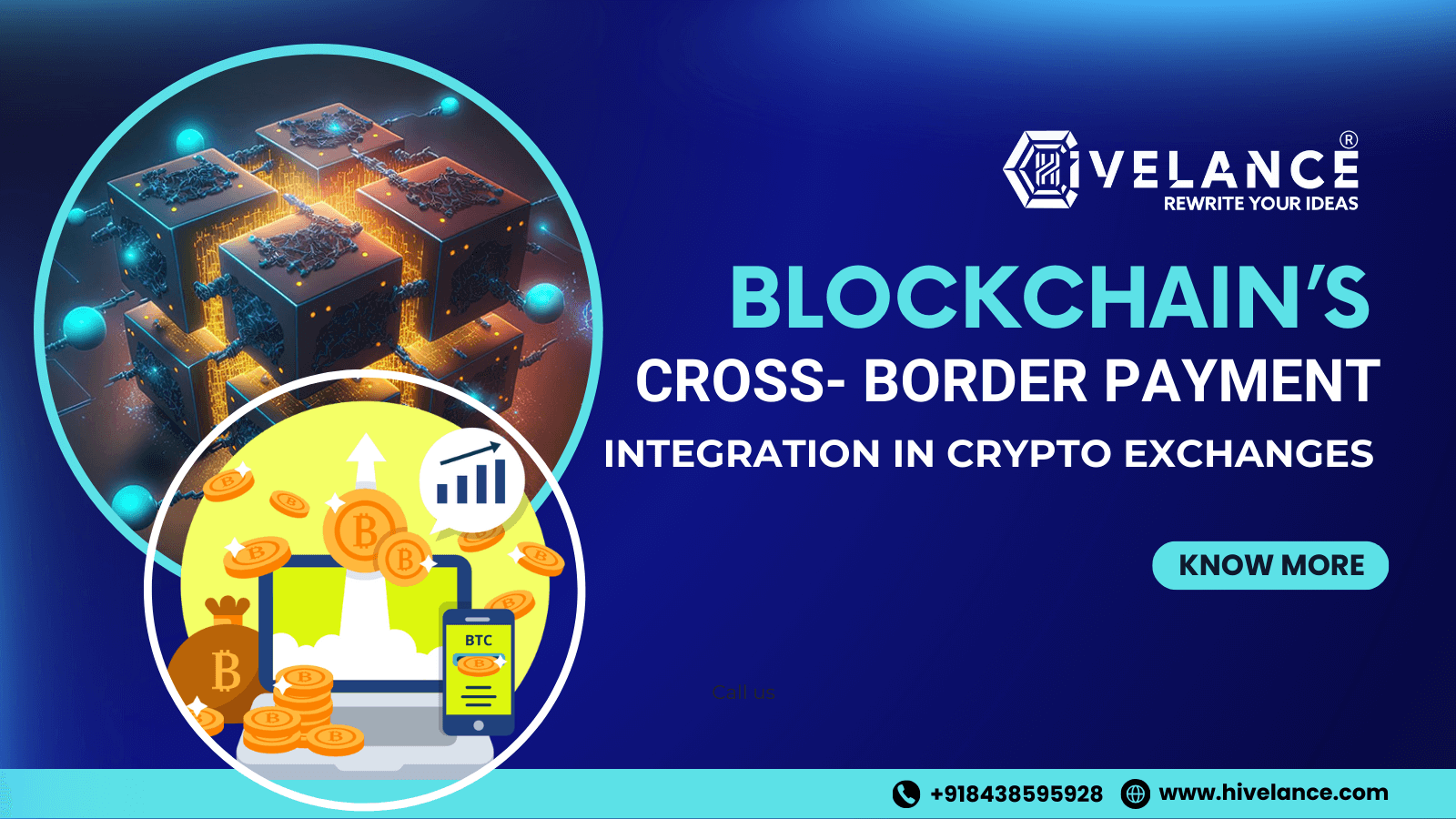Is it possible to manage an international business without sending or receiving cross-border payments? No, is the concise response.
International payments are essential to smooth financial integration and to the interconnection of the world economy. Thus, whether your business operates internationally or wants to expand, you should have dependable ways to send and receive money across borders. Cross-border payments using blockchain provide a glimmer of hope for intervention finance. They promise to make international money transfers simpler and more effective with cheaper transaction prices, blazing-fast transfer times, improved accessibility, and better transparency.
In this blog post, you can learn more about the idea of cross-border money transfers and currency exchange, and detailed usage of blockchain cross-border payment integration.
What Are Cross-Border Payments?
Cross-border payment is transferring money or other assets across international borders, and it is usually done by an individual or business. It covers a wide range of transactions by businesses involved in international trade as well as cross-border investments.
This idea has its origins in the exchange between traders and merchants. Later, as banking institutions emerged and new currencies were introduced, these trades and bank-mediated transfers took a new form. The globalization of finance, trade, and migration has led to an exceptional rise in cross-border payments in recent years. Indeed, it is projected that cross-border payments will increase dramatically, rising from US$190 trillion in 2023 to US$290 trillion in 2030.
Business perks of Cross-Border Payment Integration in Cryptocurrency Exchanges
Cross-border payment mechanism for businesses looking to enter the digital currency market, integration with cryptocurrency exchanges offers several benefits.
Save Money and Increase Efficiency:
By utilizing effective cross-border payments, businesses can reduce expenses, enhance cash flow, and reach more clients worldwide. Cryptocurrency payments lower transaction costs and expedite settlements for both consumers and merchants by doing away with banks and payment processors.
Global Payment Access:
Cryptocurrency payments enable users to send and receive money anywhere in the globe, increasing the security and privacy of cross-border trade and remittances. Geographical restrictions are removed by cross-border crypto payments allowing users to transact internationally.
Financial Inclusion:
People who lack access to traditional banking now take part in the global financial system because of crypto payments, which expand financial services to the unbanked.
Investment Opportunities:
Users who invest in cryptocurrencies have the opportunity to potentially benefit from future value growth, as doing so may result in more gains.
How Much Can You Profit on Blockchain Cross-Border Payment Solutions?
Cross-border payments via blockchain reduce costs, expedite processes, and boost transparency. Because of the intermediaries and complicated procedures involved, traditional techniques are costly and slow. Blockchain drastically lowers prices and occurs instantly or in a matter of minutes, and they are quick and more effective. Additionally, it guarantees transparency which lowers error and fraud.
By 2024, experts project a $1 trillion market as more organizations use blockchain to update their payment systems. To sum up, blockchain revolutionizes international finance by enabling quicker, cheaper, and easier access to transactions.
How does cross-border payment function?
This is a step-by-step breakdown of how international payments operate:
Initial transaction: A payment service provider or the sender's bank is used to start the payment process. Along with the recipient's name, bank account information, and amount, they also contain other facts.
Currency exchange: When a payment is made in more than one currency, it will be converted from the sender's currency to the recipient's currency by the sender's bank or the payment service provider. A currency rate determined by the bank or supplier is typically used for this.
Money transfer: Payment instructions are typically issued via international payment systems like the Society for Worldwide Interbank Financial Telecommunication (SWIFT) from the sender's bank to the recipient's bank or straight to an intermediary bank.
Banks acting as middlemen to help with the transfer: One or more intermediary banks may be needed to facilitate the transfer if there isn't a direct bank-to-bank contact between the sender and destination. The funds are subsequently transferred by these banks to the following banks in the chain.
Verifications of Compliance: To comply with international standards, such as those about Know Your Customer (KYC), Counter-Terrorism Financing (CTF), and Anti-Money Laundering (AML), compliance checks are carried out throughout the process.
Funds being received by the bank of the beneficiary: Payments can be made to the recipient's bank. This is the final step if currency conversion wasn't done in the earlier ones.
Money transfer to the beneficiary: To conclude the process of making a cross-border payment, the recipient's bank credits the monies to the recipient's bank account.
Other things to think about while sending money across borders are:
Charges
Fees associated with cross-border payments include transaction costs, service fees, and maybe bank fees for the intermediary. The price depends on the type of transaction and the provider.
Since these fees can have a big impact on the overall cost, particularly for frequent or high-volume transactions, businesses need to take them into account for cost-effective transactions.
Variations in exchange rates
Exchange rates across currencies can vary significantly, impacting the price and worth of transactions.
Businesses that send money across borders need to keep a close eye on exchange rates. They can also use hedging strategies to lessen the risks brought on by these fluctuations and maintain budgetary stability.
Delivery duration
Depending on the payment mechanism and the financial systems in both the sending and receiving countries, the processing and clearing time for cross-border money transfers can vary greatly, ranging from one day to several days.
It's critical to guarantee the proactive transfer of funds since prompt execution is essential to preserving cash flow and operational effectiveness.
Restrictions related to banks and nations
Regulations and constraints regarding cross-border transfers vary throughout nations and banks. These include AML and CMF laws that were previously stated. In addition, they might contain transaction caps, penalties, and embargoes, as well as a statement of the reason for payments and the provision of invoices, contracts, or other documentation attesting to the validity of the transaction.
In time-sensitive business operations, delays or transaction rejections might be crucial, thus it's imperative to comprehend and abide by these requirements.
Payment method accessibility
Each nation and banking service provider has a varied policy on the acceptance of certain payment methods, such as wire transfers, international ACH, and digital payment platforms.
Businesses need to think about how their partners and clients can use those same strategies as well. Making the best payment option requires weighing several considerations, including price, ease of use, security, and timeliness.
Top blockchain-based Cross-Border Payment Integration crypto exchanges
- Coinbase
- Circle Pay
- Ripple
- PayPal
- BitPay
- Stellar
Future scope
Emerging technologies like Central Bank Digital Currencies (CBDCs) and improvements in blockchain payment systems are bringing about a dramatic shift in the financial industry. We predict that digital currencies will develop significantly by 2024, especially in cross-border and business-to-business payments.
Central banks issue CBDCs, which are available in retail and wholesale forms for different types of financial organizations. Increasing mobile phone accessibility, having access to electricity, and having a dependable digital infrastructure are all necessary for developing CBDCs.
Retail CBDC issuance is the main emphasis, with over 90% of central banks worldwide actively investigating or producing CBDCs. Digital Yuan (e-CNY) is a leading initiative from China that is pursuing global adoption through intensive testing.
Important elements for a successful adoption of CBDCs include regulatory support, coordination between merchants, commercial banks, and payment service providers, education about the benefits of CBDCs, technology improvements, and security measures.
Summing-up
Thus, it is impossible to avoid international transactions for people and enterprises that are eager to transfer or receive money internationally. Since cross-border transactions have similar security, transparency, and other restrictions, it is imperative to understand these and how to overcome them. It could take specific knowledge and experience to integrate cross-border payment methods into your business framework.
Please don't hesitate to Contact Hivelance if you need this or any other kind of help with fintech solutions.
 Trends
Trends
 Crypto
Crypto
 Web 3.0
Web 3.0
 AI
AI
 Blockchain
Blockchain
 Fintech
Fintech
 Company
Company



















